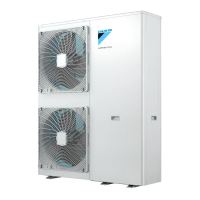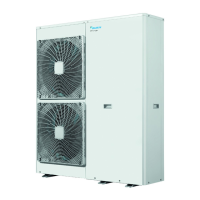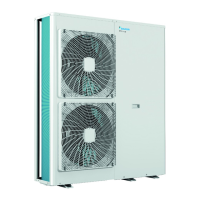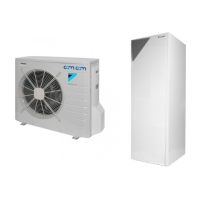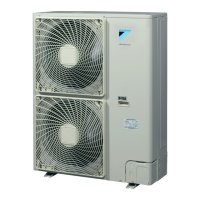5 Application guidelines
Installer reference guide
22
EBLQ+EDLQ011~016CAV3+W1 + EK(2)CB07CAV3 +
EKMBUHCA3V3+9W1
Daikin Altherma low temperature monobloc
4P522034-1 – 2018.01
▪ For the standalone DHW tank: If there is no electrical backup
heater in the space heating circuit, you must install a DHW pump
for tank preheating.
Configuration
The outdoor unit can control DHW pump operation. For more
information, see "8Configuration"on page50.
5.5 Setting up the energy metering
▪ Via the user interface, you can read out the following energy data:
▪ Produced heat
▪ Consumed energy
▪ You can read out the energy data:
▪ For space heating
▪ For space cooling
▪ For domestic hot water production
▪ You can read out the energy data:
▪ Per month
▪ Per year
INFORMATION
The calculated produced heat and consumed energy are
an estimation, the accuracy cannot be guaranteed.
5.5.1 Produced heat
INFORMATION
The sensors used to calculate the produced heat are
calibrated automatically.
INFORMATION
If glycol is present in the system ([E‑0D]=1]), then the
produced heat will NOT be calculated, nor will it be
displayed on the user interface.
▪ Applicable for all models.
▪ The produced heat is calculated internally based on:
▪ The leaving and entering water temperature
▪ The flow rate
▪ The power consumption of the booster heater (if applicable) in
the domestic hot water tank
▪ Setup and configuration:
▪ No additional equipment needed.
▪ Only in case a booster heater is present in the system, measure
its capacity (resistance measurement) and set the capacity via
the user interface. Example: If you measure a booster heater
resistance of 17.1Ω, the capacity of the heater at 230 V is
3100W.
5.5.2 Consumed energy
You can use the following methods to determine the consumed
energy:
▪ Calculating
▪ Measuring
INFORMATION
You cannot combine calculating the consumed energy
(example: for backup heater) and measuring the
consumed energy (example: for outdoor unit). If you do so,
the energy data will be invalid.
Calculating the consumed energy
▪ The consumed energy is calculated internally based on:
▪ The actual power input of the outdoor unit
▪ The set capacity of the booster heater and the optional backup
heater
▪ The voltage
▪ Setup and configuration: To get accurate energy data, measure
the capacity (resistance measurement) and set the capacity via
the user interface for:
▪ The optional backup heater (step1 and step2)
▪ The booster heater
Measuring the consumed energy
▪ Preferred method because of higher accuracy.
▪ Setup and configuration:
▪ Requires option box EK2CB07CAV3.
▪ Requires external power meters.
▪ When using electrical power meters, set the number of pulses/
kWh for each power meter via the user interface.
INFORMATION
When measuring the electrical power consumption, make
sure ALL power input of the system is covered by the
electrical power meters.
5.5.3 Normal kWh rate power supply
General rule
One power meter that covers the entire system is sufficient.
Setup
▪ Install control box EKCB07CAV3 and option box EK2CB07CAV3.
▪ Connect the power meter to X2M/7 and X2M/8 of option box
EK2CB07CAV3.
Power meter type
In case of… Use a… power meter
Backup heater supplied from a
single-phase grid (i.e. the backup
heater model is *3V or *9W
connected to a single-phase grid)
Single-phase
In other cases (i.e. a *9W backup
heater model connected to a
three-phase grid)
Three-phase
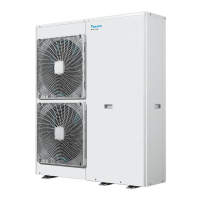
